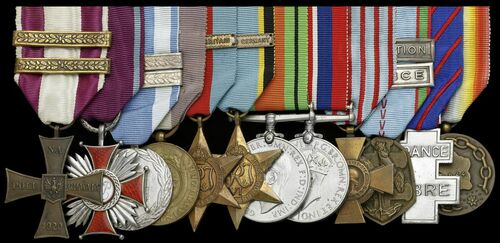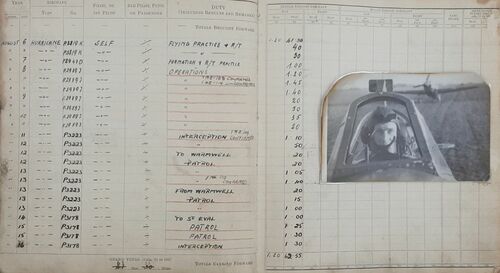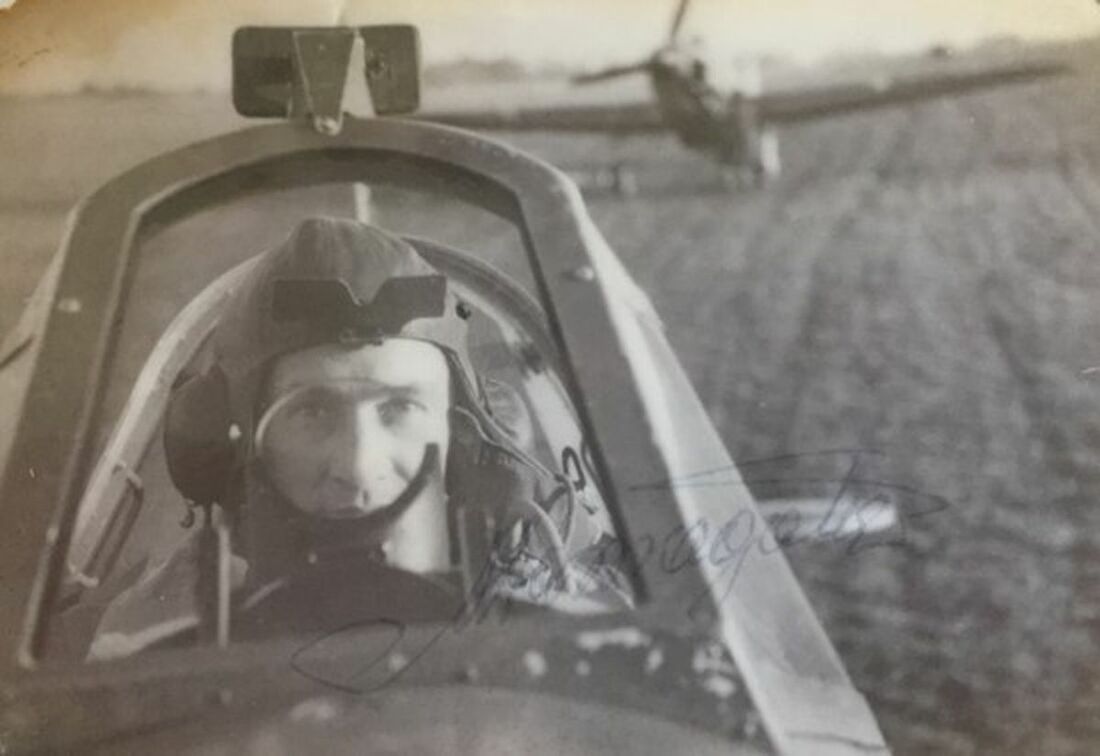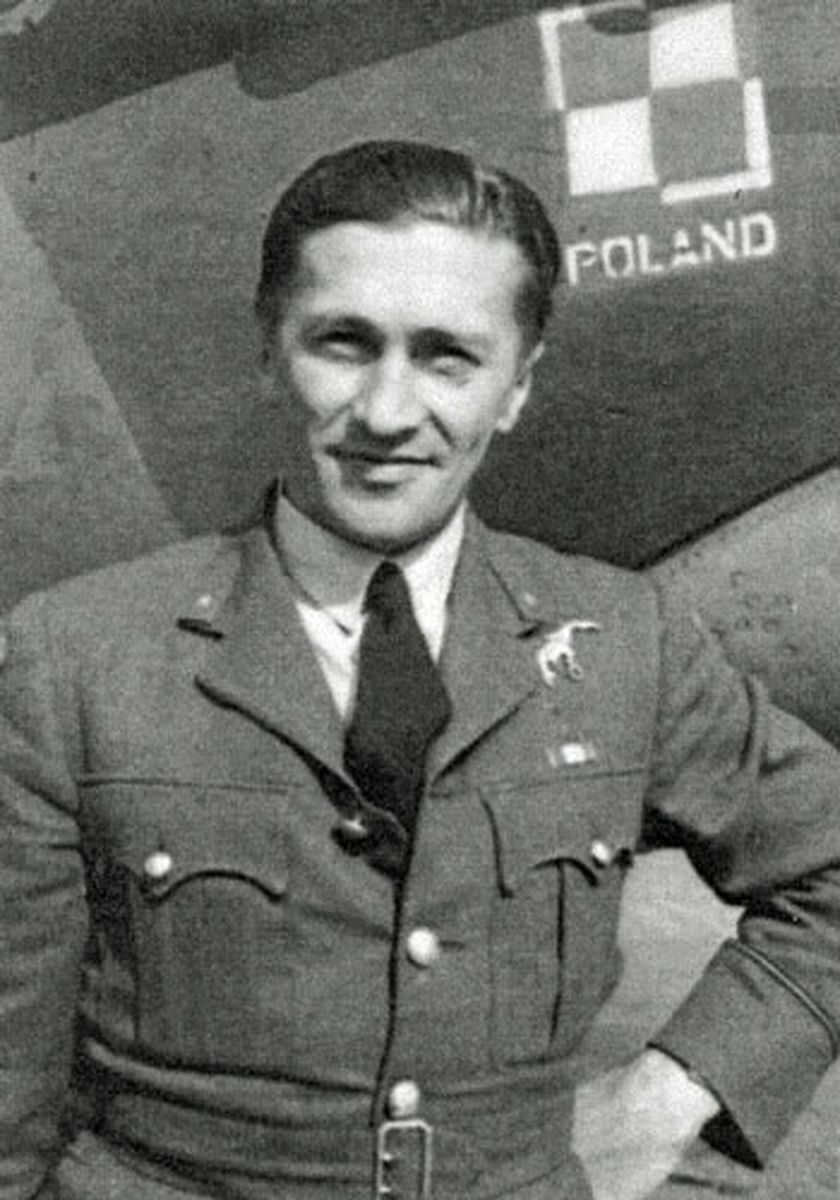Auction: 23002 - Orders, Decorations and Medals
Lot: 63
(x) 'I was Yellow 2 and the section was ordered (with the remainder of 238 Squadron) to intercept a raid on a convoy. I took off at 12.09 and arrived over the convoy at approximately 12.35 hours. Yellow Leader ordered line astern. I saw a Me. 109 ahead and went for him but he was very speedy and I could not catch up. I saw another Me. 109 which was in a bank and I do not think he saw me and I fired from astern 2 one-second bursts from about 100 yards. I closed him and fired another very short burst from 50 yards and broke away to avoid over-shooting. The E./A. did a stall turn and went straight down, smoking, and then caught fire. I then saw it go into the sea.
I then climbed and saw many E./A. and when I got near I recognised them as 110s. I saw one E./A. go away and I chased him and was in a very good position almost astern. I got closer and slightly below and fired from approximately 150 yards, one short burst at slight deflection. I don't think there was a gunner in the Me. 110 as I did not see any return fire. I then followed the E./A. which went into a dive doing slight aileron turns. I did not see any smoke or flames but I saw the bullets (tracer) going into the E./A. I think the gunner must have been killed.
Then I saw E./A. behind me, so I broke off and climbed and did not see any more. I saw one man on a parachute but do not know where he came from. I feel sure the E./A. was out of control, but did not see it go into the sea. I landed at Middle Wallop at 14.40 hours. Number of rounds fired: 800.'
Sergeant M. B. Domagala of No. 238 Squadron opens his Battle of Britain account in style, in a combat off The Needles on 8 August 1940.
A notable Second World War fighter pilot's group awarded to Flight Lieutenant M. B. Domagala, Polish Air Force
A gallant and reliable wingman, he fought in Hurricanes of No. 238 Squadron at the height of the Battle of Britain, claiming three confirmed 'kills' in August 1940, the first of them believed to be the first victory obtained by a Polish pilot over the U.K.
He was also fortunate to survive being shot down over the Channel in a Hurricane of No. 302 'Poznan' Squadron in May 1941, at length being fished out of the drink by a naval launch: offered the choice of a cup of tea or a whisky by the skipper, he unhesitatingly - and understandably - chose that latter
Having then completed a third tour of operations in Spitfires of No. 317 'Wilno' Squadron - and been awarded the Polish Cross of Valour with multiple Bars - Domagala was rested with an appointment in Training Command
Poland, Republic, Cross of Valour, with Second and Third Award Bars; Cross of Merit, silver and enamel; Air Force Medal, with Second and Third Award Bars; Long Service Medal for 10 Years; 1939-45 Star, copy clasp, Battle of Britain; Air Crew Europe Star; Defence and War Medals 1939-45; France, Republic, Combatants Cross; 1939-45 War Medal, 2 clasps, France, Liberation; Free France Commemorative Medal; Medal of a Liberated France, mounted court-style as worn, very fine (12)
Marian Boguslaw Domagala was born in Lubin, Poland on 23 March 1909 and, on completing his education, commenced flying training at Lublin Aero Club. Otherwise employed as an aero engine fitter in an aircraft factory, he was called up for national service in 1930, when he joined the 3rd Air Force Regiment.
Early career
Having then attended a pilot's course, he was posted to 132 Fighter Squadron at Poznan, followed by a stint as a flying instructor. Then in 1936 he joined 162 Fighter Squadron at Deblin, and it was in this capacity that he first saw action in September 1939.
Later in the same month, he was sent to Rumania in an attempt to collect reinforcement aircraft, but it was to prove an unsuccessful assignment and he was taken prisoner by the Russians on returning to Poland. With two friends, however, he escaped from a transit camp and, reaching Rumania in late October 1939, was embarked in a ship bound for Syria. He then gained passage in another ship to Marseilles, from whence he joined the Polish Air Force at Lyon in February 1940.
The details of his subsequent journey to England, following the fall of France, remain shrouded in mystery, although he later recalled being offered 'dainty water cress sandwiches' on his arrival. Subsequently joining the Free Polish Air Force, he was posted to R.A.F. Eastchurch and thence to a pilot's refresher course.
The Battle
On 6 August 1940, Domagala joined the strength of No. 238 Squadron at Middle Wallop and he quickly made his mark. In fact, just two days later, in a midday combat six miles south of The Needles, he claimed a Me. 109 confirmed and a Me. 110 as a probable, although Polish records also confirm the Me. 110 as destroyed; see his related combat report, as quoted above.
On 11 August, his marksmanship drew further blood, when he destroyed another Me. 109 in a combat at 6,000 feet just east of Weymouth. As outlined in his related combat report, however, he also unavoidably shot down a Hurricane that crossed his line of fire. Luckily the pilot was able to bail out:
'I was Yellow 2 in A Flight and was ordered to Portland at 20,000 feet. Yellow 1 gave line astern but I broke away to the right and engaged a Me. 109. Just as I opened fire at the E./A. a Hurricane appeared in my line of sight between the E./A. and myself and got the tail end of the burst which was a very short burst of two seconds at a range of 50 yards quarter attack. My burst went into the left wing of the Hurricane, which was smoking, and the pilot bailed out.
I watched him down and then attacked another Me. 109 after climbing. I fired a very short burst at 150 yards range from astern but the E./A. dived and I followed it down, and as he weaved I fired each time - about three times - from quarter deflection and very close range at about 100 yards. The E./A. climbed slightly and then fell into the sea with a splash. I had fired all my ammunition, so I returned to base after several attacks had been made on me by several E./A., which I evaded. I landed at Warmwell first, re-armed and went back on patrol.
I landed at Middle Wallop at 11.35 hours. Number of rounds fired: 2,400, and 80 after re-arming.'
Finally, in another combat fought on the 13 August, Domagala appears to have claimed a Me. 110. The Squadron O.R.B. certainly confirms his presence in a hotly contested action over Portland on that date, in addition to stating that three Me. 110s were confirmed as destroyed.
However, in mid-September, he was placed on the non-effective sick list, and remained so for at least two months. But he subsequently returned to operational flying, a case in point being the 20 March 1941, when, as reported in his Flying Log Book, he ran out of petrol after a long chase and forced landed near Warmwell, with his under-carriage up in very thick weather.
For his gallant work in the Battle, Domagala was awarded the Polish Cross of Valour on 23 December 1940, and added a Bar to his decoration on 1 February 1941.
Further action in 302 'Poznan' and 317 'Wilno' Squadrons
In April 1941, Domagala transferred to No. 302 'Poznan' Squadron at Westhampnett and he remained actively employed in that role until mid-September 1941, flying regular convoy patrols.
Shortly after his arrival - on 29 April - and following a combat with 109s over the Channel, Domagala's Hurricane's engine 'died' at 27,000 feet over Dungeness, and he attempted to glide towards Biggin Hill, the nearest airfield. He stalled and crashed just before reaching the runway but emerged from the wreckage unhurt.
Then a little over a week later - on 8 May - he was jumped and shot down over the Channel, whilst patrolling at 28,000 feet. By his own account his tail plane was shot away. Taking to his parachute, and thanks to his Mae West, he survived a prolonged period in the drink before being rescued by a naval launch. Here, then, the welcome offer of a glass of whisky, followed by several days in hospital - 'the exposure in the water affected my health for a time'.
In September 1941, Domagala commenced his third operational tour with an appointment in 317 'Wilno' Squadron at Exeter, and he remained likewise employed until January 1942, flying further patrols in the unit's Spitfires, until he was rested with an appointment in Training Command.
He saw no further action and was commissioned as a Pilot Officer in the General Duties Branch of the Polish Air Force in June 1942. He was subsequently advanced to Flying Officer in December of the same year and to Flight Lieutenant in June 1944.
Post-war
Post-war, Domagala was granted a commission in the Polish Resettlement Corps (R.A.F.) and he remained similarly employed until March 1949. He then settled at Kilbride in Scotland, where he worked in engineering.
Domagala made just one return visit to Poland, in the late 1960s, and, as reported in the press, it turned out to be a memorable trip. Having upset a communist security officer during his outward flight to Warsaw, and been roughly treated on landing, he suffered further anxiety when ordered to an airport interrogation room just before his return flight three weeks later.
He needn't have worried, for the authorities had researched his background and congratulated him on his gallant wartime career. A bottle of vodka and glasses were swiftly handed out, as they informed him that he 'was the first Polish pilot during the Battle of Britain to chalk up a kill': "That was news to me - but it turns out to be true."
The gallant Domagala died in January 1991.
Sold with his original R.A.F. Pilot's Flying Log Book, with signed opening endorsement confirming 2,200 hours on single-engine aircraft in the period 1931-39 and two pasted down wartime photographs, the content covering the period July 1940 to February 1944; together with a copy of a Polish publication with extensive photographic coverage of Polish Battle of Britain pilots (Warsaw, 1972), and a bound volume containing relevant O.R.B. entries and combat reports relating to Domagala's operational career.
Subject to 5% tax on Hammer Price in addition to 20% VAT on Buyer’s Premium.
Sold for
£18,000
Starting price
£2500













